Poverty in Perspective: a typology of poverty in Scotland
Sets out 13 different ‘types’ of poverty across three life stages: families with children, working age households without children, and pensioner households.
Poverty types: Working age without children
The analysis of the working age adults without children life stage revealed four poverty types:

The four segments above show the proportions of low income households in the 'working age families without children' life stage that are in each poverty type.
This chapter now goes on to describe the households in each poverty type, explaining the combination of indicators that households face. Given knowledge of how particular forms of poverty interact for households, there is also discussion of how policy makers and service providers can reach and help households in each poverty type.
Working age without children: 'Insecure singles'
Who they are
This group is similar to the 'insecure singles' type described in 'Poverty in Perspective'. They are one of the most vulnerable groups in Scotland, suffering from multiple disadvantages across health, education, housing and employment. The high rate of previous homelessness amongst this group (59%) is distinctive - the next highest rate for the cohort is much lower (20%, among 'socially detached singles'). People who are homeless are at an increased risk of becoming homeless again in the future. Around half of this group also suffer from health issues, which could include mental health problems and substance abuse issues, both of which are associated with a higher risk of homelessness and poor housing. 65% of insecure singles are men, and over half are between 25 and 44 years of age.
How to reach them
Identifying this group is likely to be difficult. As people in this group are childless, they do not use many of the services that can identify parents who are struggling, such as childcare services. Furthermore, if a person in this group become homeless once again ( e.g. after falling behind on their rent and being evicted) they might fall off the radar, so to speak.
Breakdown of poverty indicators for the 'insecure
singles'

One way of identifying this group is through registered social landlords ( RSLs) - 72% of this group are social tenants. Other outreach vehicles include job centres, given the high level of benefit use, and also debt advice organisations and homelessness charities, and health and substance abuse support groups who might have been in contact with this group during periods of homelessness. Finally, food banks might have contact with this group.
How to help them
In order to reduce poverty for this group, the services described above need to work together to provide effective support. This group is a classic "multiple user" of many agencies - statutory and voluntary. The priority may not be to invest more resources to support this group, as much as to better coordinate and rationalise what is already in place. Identifying this group, and agencies working together to recognise they are dealing with the same people from different points of view, is the first step towards better coordination.
Interventions for this group should also focus on employment support - although the kind of support needed will depend on age. 65% of this group are aged 16-44, and the remainder 45 or over. Older and younger 'insecure singles' are likely to experience different challenges. Younger people in the group may have never worked, having left school and taken up benefits. They will need support aimed at enabling them to take their first steps into the world of work, which will include a focus on building their confidence. On the other hand, older (working age) people in the group are more likely to have worked before, but have possibly been made redundant, separated from a partner or experienced a bout of poor health, and need help to re-enter work and re-build their confidence. People with health problems in this group, whether young or old, will also need further support to help them manage their condition in the workplace.
Socio-demographic characteristics of the 'insecure
singles'
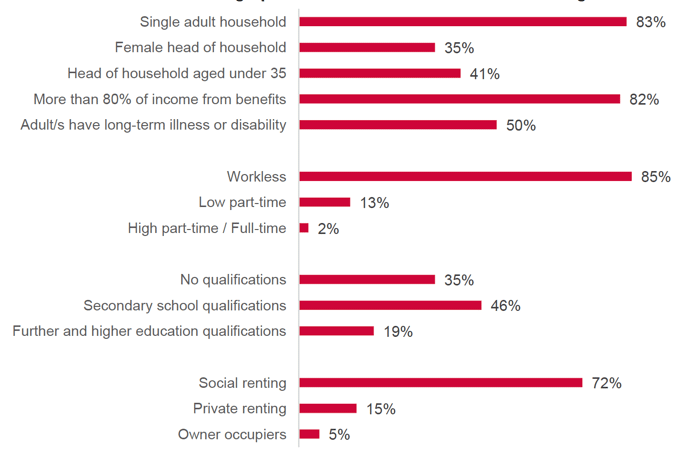
Welfare reform poses a particular risk to people in this group, given that the vast majority of their income comes from benefits, and they are highly vulnerable on a number of other indicators.
Working age without children: 'Socially detached singles'
Who they are
'Detached singles' and older 'insecure singles' appear to have very similar experiences. They are workless, mainly single people living in social housing, receiving the majority of their income from benefits. They do not have savings to act as a buffer when their income drops. Both groups have a similar gender split: 60% of detached singles are men.
However, there are some subtle differences between the groups. 'Detached singles' are less likely to have internet access or to participate in cultural activities, making them more disconnected. They are also slightly less likely to say they are struggling financially, and slightly less likely to live in the most deprived neighbourhoods. It is possible that these differences are simply a result of the fact that they are older than 'insecure singles' - 69% are above the age of 45. 'Insecure singles' may become 'Detached singles' as they get older.
Breakdown of poverty indicators for the 'socially detached
singles'

How to reach them
As with the 'insecure singles' group, this group could be identified through RSLs, job centres, food banks and debt advice organisations. A much smaller proportion in this group have been homeless, but a higher proportion have health problems (likely due to their older age profile), so health services are an additional identification route. The former employers of people in this group may be able to help identify them, too.
How to help them
The key challenge for this group is finding work that they can sustain until retirement. Given the health conditions experienced by this group, employment support needs to be integrated with health advice if it is to help them re-enter the workforce.
The support for this group should not end once they are back in work. Being close to retirement age, this group should be helped to prepare for a smooth transition to life after work - planning for the financial and legal consequences of leaving work, and also for the social consequences. The latter is particularly important for men, whose social lives and identity are often closely linked to the work place.
Socio-demographic characteristics of the 'socially detached
singles'
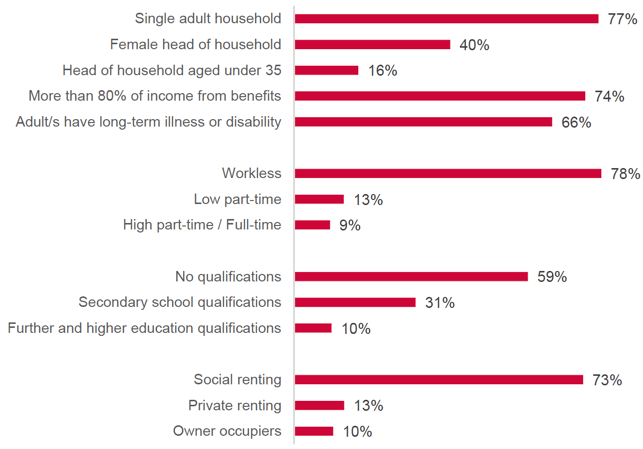
Working age without children: 'New poor'
Who they are
Three quarters of this group are in the bottom two income deciles, despite the group showing few signs of deprivation on the other poverty indicators. The majority are homeowners (or buying their home with a mortgage), 68% are in work, and few live in deprived neighbourhoods. This suggests that these households may have experienced reductions in income only recently. A number of factors could be behind this, such as age (the majority of this group are aged 45 and over), ill health and fluctuations in the wider economy. 17% of people in this group are carers, which could explain why a proportion of this group work part time, and might be another reason behind a drop in income for some. The vast majority of the 'new poor' have savings - dipping into these might enable them to cope in the short term, but may not be sustainable.
How to reach them
Similar to the 'Working home owners' child poverty type, the 'new poor' may not be found using services typically associated with low incomes. Their lack of children means they cannot be reached through childcare centres and schools. The best way of identifying this group, therefore, might be through their employers and health services.
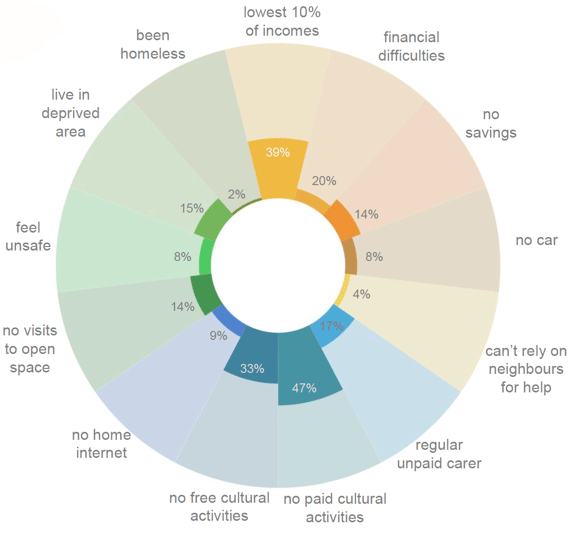
How to help them
The key focus of interventions for this group should be on financial management in the short term, and boosting the number of hours they work in the medium term.
They may benefit from financial management while they adjust to their reduced income. They may have savings, but it is possible that they are not making the most of them, not having needed to in order to maintain a good standard of living in the past.
Benefits maximisation might also be effective for them, as they may not be claiming all the benefits they are entitled to - such as tax credits, Income Support for those in work and Employment and Support Allowance for those unable to work due to ill health (or Universal Credit when it replaces these benefits). People experiencing a sudden drop in income may not be familiar with the sources of financial support available, having never needed it before.
A longer term strategy for protecting the 'new poor' is to help them increase the number of hours they work. As some of this group have health conditions and/or caring responsibilities, employers may need to offer flexible working in order for this to be possible. However, the 'new poor' are relatively well qualified (51% have level 2 qualifications or above, and 23% have a degree) and are likely to be experienced, so there are good business reasons for offering flexibility.
Socio-demographic characteristics of the 'new
poor'
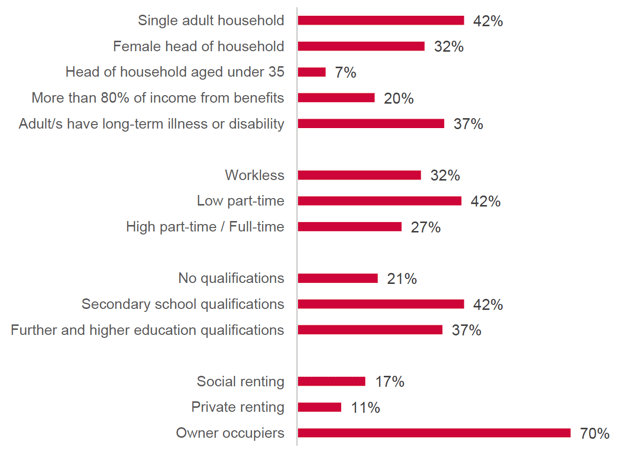
Working age without children: 'Generation rent'
Who they are
These young, well qualified singles tend to live in rented accommodation (over half in private rented), and two thirds live alone. There is an equal split of women and men. Some may be students whose low income is due to them studying, or having recently finished their studies and not yet entering the world of work. They do not tend to experience significant financial difficulties.
How to reach them
The students in this group may be relatively easy to reach - student and more general youth outreach activities are well developed in Scotland, and preventative work might take place in universities. However, the Independent Advisor on Poverty to the Scottish Government has recommended targeting support to help young people not destined for Higher Education find worthwhile employment (Scottish Government, 2016). Consideration needs to be given to how best to reach these young people if, after leaving school, they become private renters and may only become 'visible' to support once they become longer term unemployed. Working early on with schools, as well as FE colleges and employers/apprentice organisations, will also be important.
Breakdown of poverty indicators for the 'generation rent'
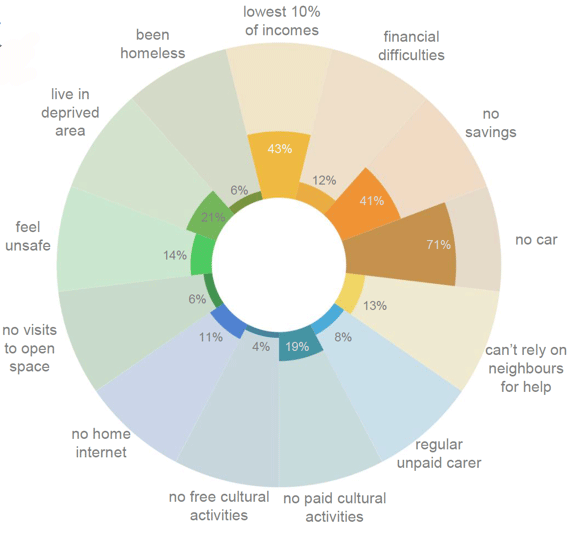
How to help them
One might argue that, for this group, poverty is transient - students while still studying or soon to enter work do have low incomes, yet their poverty is a precursor to far better incomes and standards of living. Therefore, we might consider this group a low priority when it comes to poverty strategies. That said, this group are mainly renters, probably with little savings. Some have higher educational qualifications (with the social and other benefits attending a university may bring), but many do not. They remain, therefore, financially vulnerable. For those who cannot rely on their families for financial support, their relatively comfortable circumstances are not sustainable over the long term and depend entirely on securing decent employment.
Ensuring this group have access to financial advice and careers advice early on will be crucial in ensuring their poverty does not become a longer term, entrenched problem. With a labour market that may suffer in the run up and post-Brexit, under-employment or over-qualification may become more of an issue and well qualified young people may find themselves unable to translate their skills into well paid employment. Support for those not entering Higher Education but perhaps continuing their training in other ways will be vital, through a credible vocational and apprenticeship offer and strong careers advice to create clear pathways into work.
This group are also vulnerable to rent rises in the urban centres they primarily live in, and unable to accumulate savings needed to get onto the housing ladder. Affordable housing and opportunities for shared ownership will also be an important preventative measure, giving this group a level of resilience against a turbulent private rental market, and helping to lift them out of poverty as and when their incomes increase.
Socio-demographic characteristics of the 'generation
rent'

Contact
There is a problem
Thanks for your feedback